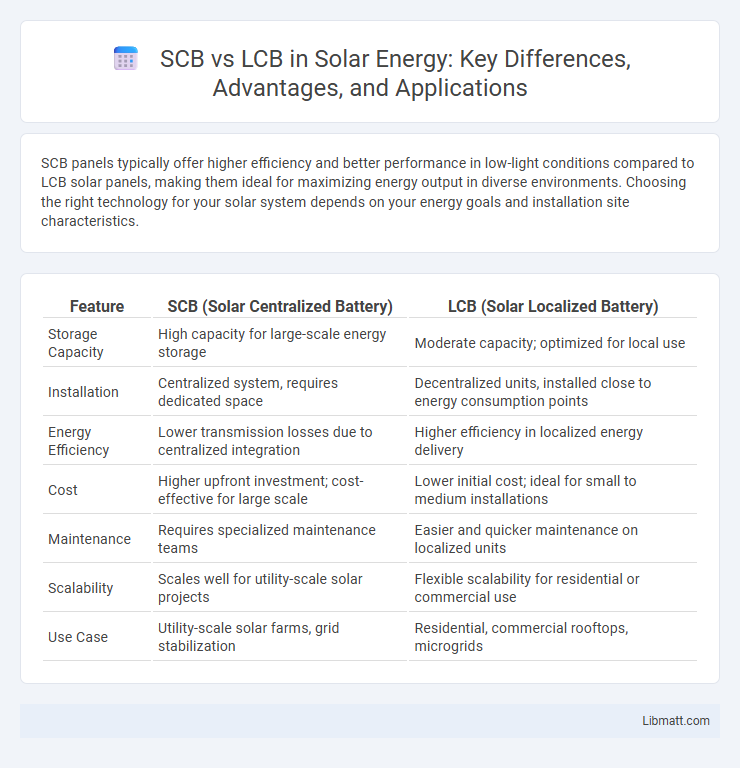SCB panels typically offer higher efficiency and better performance in low-light conditions compared to LCB solar panels, making them ideal for maximizing energy output in diverse environments. Choosing the right technology for your solar system depends on your energy goals and installation site characteristics.
Table of Comparison
| Feature | SCB (Solar Centralized Battery) | LCB (Solar Localized Battery) |
|---|---|---|
| Storage Capacity | High capacity for large-scale energy storage | Moderate capacity; optimized for local use |
| Installation | Centralized system, requires dedicated space | Decentralized units, installed close to energy consumption points |
| Energy Efficiency | Lower transmission losses due to centralized integration | Higher efficiency in localized energy delivery |
| Cost | Higher upfront investment; cost-effective for large scale | Lower initial cost; ideal for small to medium installations |
| Maintenance | Requires specialized maintenance teams | Easier and quicker maintenance on localized units |
| Scalability | Scales well for utility-scale solar projects | Flexible scalability for residential or commercial use |
| Use Case | Utility-scale solar farms, grid stabilization | Residential, commercial rooftops, microgrids |
Introduction to SCB and LCB in Solar Systems
SCB (Solar Charge Battery) and LCB (Lithium Carbon Battery) are critical components in solar energy storage systems that influence performance and durability. SCB typically refers to traditional lead-acid batteries designed for solar applications, offering cost-effective energy storage with moderate cycle life and efficiency. LCB, representing advanced lithium-ion technology, provides higher energy density, longer lifespan, and faster charge/discharge rates, making it ideal for modern solar systems requiring reliable and efficient power management.
What is a String Combiner Box (SCB)?
A String Combiner Box (SCB) in solar photovoltaic systems consolidates multiple solar panel strings into a single output, simplifying wiring and enhancing system management. SCBs provide overcurrent protection and facilitate easy maintenance by integrating fuses or circuit breakers for each string. By optimizing cable runs and safeguarding components, SCBs improve overall solar array efficiency and safety compared to using separate connections like Local Combiner Boxes (LCB).
What is a Line Combiner Box (LCB)?
A Line Combiner Box (LCB) is a vital component in solar power systems that consolidates multiple solar panel strings into a single output, simplifying wiring and improving system efficiency. Unlike standard SCBs, LCBs include integrated fusing and protection mechanisms to safeguard each string from faults or failures. Your solar array benefits from an LCB by enhancing safety, reducing installation complexity, and optimizing overall system management.
Key Functions of SCB in Photovoltaic Installations
SCB in photovoltaic installations acts as a critical safety mechanism by providing overcurrent and short-circuit protection to solar panels and connected inverters. These devices ensure the stability and reliability of solar power systems by interrupting fault currents, preventing damage to your equipment and reducing fire risks. Key functions of the SCB include isolating faulty sections, enhancing system longevity, and maintaining efficient energy flow within solar arrays.
Main Roles of LCB in Solar Power Plants
LCB (Low Concentration Beam) technology in solar power plants primarily enhances light capture efficiency by concentrating sunlight onto photovoltaic cells, increasing energy output without the need for high-cost materials. It supports thermal regulation and improves overall system durability by reducing heat stress on solar modules. Your solar project benefits from LCB's ability to optimize power generation while maintaining cost-effectiveness and operational stability.
SCB vs LCB: Core Differences and Applications
SCB (Single Crystalline Silicon) solar panels exhibit higher efficiency and better performance in low light conditions compared to LCB (Low-Cost Bilayer) solar technologies, which prioritize affordability and ease of manufacturing. SCB panels are commonly used in residential and commercial solar installations requiring maximum power output and long-term reliability, while LCB panels suit large-scale utility projects where cost-effectiveness outweighs marginal efficiency losses. The fundamental material properties of SCB enable superior electron mobility and stability, whereas LCB's layered design reduces production costs and supports flexible applications.
Advantages of Using SCB in Solar Projects
SCB (Silicon Carbide Bipolar) technology offers significant advantages in solar projects by providing higher efficiency and better thermal conductivity compared to traditional LCB (Low Carbon Bipolar) systems. This results in reduced energy losses and prolonged lifespan of solar inverters and converters, maximizing power output and reliability. By integrating SCB components, your solar installation can achieve superior performance in high-temperature environments, ensuring consistent energy generation and lower maintenance costs.
Benefits of LCB in Large-Scale Solar Installations
LCB panels deliver higher efficiency and improved energy yield in large-scale solar installations by utilizing lightweight materials and advanced cooling technologies. Their modular design reduces installation time and lowers balance-of-system costs, enhancing overall project scalability. Enhanced durability and resistance to environmental stress make LCB an ideal choice for long-term solar farm performance and reliability.
SCB or LCB: Which to Choose for Your Solar System?
Selecting between SCB (Single-Phase Circuit Breaker) and LCB (Load Circuit Breaker) for your solar system depends on the system's capacity and safety requirements. SCBs are ideal for smaller residential solar setups, offering reliable protection against overcurrent in single-phase systems, while LCBs suit larger or three-phase installations with higher load demands, providing enhanced current interruption capabilities. Evaluating your solar system's power output and configuration will help determine whether SCB or LCB best ensures optimal performance and safety.
Future Trends in Solar Combiner Box Technologies
Emerging trends in SCB (Solar Combiner Box) technologies emphasize enhanced smart monitoring systems and IoT integration, enabling real-time data analysis and predictive maintenance. Future designs prioritize modularity and scalability, supporting larger solar arrays with improved safety features like arc fault detection and rapid shutdown mechanisms. Advanced materials and thermal management solutions are also being developed to increase efficiency and durability under extreme environmental conditions.
SCB vs LCB (Solar) Infographic

 libmatt.com
libmatt.com